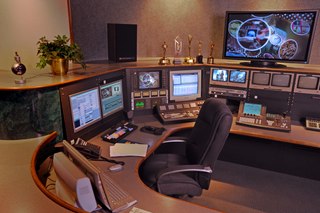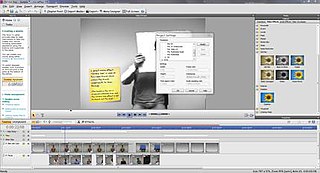
Non-linear editing is a form of offline editing for audio, video, and image editing. In offline editing, the original content is not modified in the course of editing. In non-linear editing, edits are specified and modified by specialized software. A pointer-based playlist, effectively an edit decision list (EDL), for video and audio, or a directed acyclic graph for still images, is used to keep track of edits. Each time the edited audio, video, or image is rendered, played back, or accessed, it is reconstructed from the original source and the specified editing steps. Although this process is more computationally intensive than directly modifying the original content, changing the edits themselves can be almost instantaneous, and it prevents further generation loss as the audio, video, or image is edited.
Video editing is the post-production and arrangement of video shots. To showcase perfect video editing to the public, video editors must be reasonable and ensure they have a superior understanding of film, television, and other sorts of videography. Video editing structures and presents all video information, including films and television shows, video advertisements and video essays. Video editing has been dramatically democratized in recent years by editing software available for personal computers. Editing video can be difficult and tedious, so several technologies have been produced to aid people in this task. Overall, video editing has a wide variety of styles and applications.

iMovie is a free video editing application made by Apple for the Mac, the iPhone, and the iPad. It includes a range of video effects and tools like color correction and image stabilization, but is designed to be accessible to users with little or no video editing experience. iMovie's professional equivalent is Apple's Final Cut Pro X.

Final Cut Pro is a professional non-linear video-editing application initially developed by Macromedia, and, since 1998, by Apple as part of its pro apps collection. Final Cut Pro allows users to import, edit, and process video footage, and output it to a wide variety of formats.

Adobe Premiere Pro is a timeline-based and non-linear video editing software application (NLE) developed by Adobe and published as part of the Adobe Creative Cloud licensing program. First launched in 2003, Adobe Premiere Pro is a successor of Adobe Premiere. It is geared towards professional video editing, while its sibling, Adobe Premiere Elements, targets the consumer market.

Windows Movie Maker is a discontinued video editing software program by Microsoft. It was first included in Windows Me on September 14, 2000, and in Windows XP on October 25, 2001. It later became a part of the Windows Essentials software suite, and offered the ability to create and edit videos as well as to publish them on OneDrive, Facebook, Vimeo, YouTube, Windows Live Groups, and Flickr. It is comparable to Apple's iMovie.

Vegas Pro is a professional video editing software package for non-linear editing (NLE). The first release of Vegas Beta was on 11 June 1999. The software runs on the Windows operating system.

LiVES (LiVES Editing System) is a free and open-source video editing software and VJ tool, released under the GNU General Public License version 3 or later. There are binary versions available for most popular Linux distributions (including Debian, Ubuntu, Fedora, Suse, Gentoo, Slackware, Arch Linux, Mandriva and Mageia). There are also ports for BSD, and it will run under Solaris and IRIX. It has been compiled under OS X Leopard, but not thoroughly tested on that platform. In early 2019, a version for Microsoft Windows was announced, with a release slated for in the second half of 2019.
Media 100 is a manufacturer of video editing software and non-linear editing systems designed for professional cutting and editing. The editing systems can be used with AJA Video Systems, Blackmagic or matrox hardware or as software-only solution with Firewire support and run exclusively on Macs. The current released software version is Media 100 Suite Version 2.1.8 and runs on macOS 10.14.x (Mojave), macOS 10.13.4, macOS 10.12 (Sierra), OS X 10.11, OS X 10.10 (Yosemite), OS X 10.6.7, 10.7.x (Lion), 10.8.x, 10.9.x (Mavericks) and 10.10.x (Yosemite).

Avid Media Composer is a video editing application or non-linear editing system (NLE) developed by Avid Technology. It was initially released in 1989 as an offline editing system on the Macintosh II. Since the 1990s, Media Composer has been the dominant non-linear editing system in the high-end film and television industry, allowing offline and online editing workflows, including up to 16K editing and finishing. Much of its design, implementation, and terminology is derived from the people and practices found in filmmaking and broadcast.

Serif MoviePlus was a non-linear video editor created by Serif Europe that allowed both professional and home users to edit digital video and digital images.

Kdenlive is a free and open-source video editing software based on the MLT Framework, KDE and Qt. The project was started by Jason Wood in 2002, and is now maintained by a small team of developers.

Nero Video is a video editing software from Nero AG that provides simple editing functions as well as advanced video editing, which includes multitrack timeline and key framing functions. Nero Video also provides a wide range of functions for including photos and music in video projects, as well as a broad selection of transition, video, audio and title effects. In addition, it includes templates for semi-automatic film creation and for picture-in-picture effects. Once editing is complete, users can export their finished film as a file or upload it to the web. They can also use Nero Video to burn the film onto DVDs and Blu-rays and personalize the discs’ menu and chapters step by step. Video disc creation is a separate module and can be executed directly from the start screen. That enables users to complete their disc-only projects quickly and easily. This authoring module also includes simple cropping and arranging tools.

CinemaDNG is the result of an Adobe-led initiative to define an industry-wide open file format for digital cinema files. CinemaDNG caters for sets of movie clips, each of which is a sequence of raw video images, accompanied by audio and metadata. CinemaDNG supports stereoscopic cameras and multiple audio channels. CinemaDNG specifies directory structures containing one or more video clips, and specifies requirements and constraints for the open format files,, within those directories, that contain the content of those clips.
Movie Edit Pro is a video editing software developed by Magix for semi-professional and DIY users for Windows PC. It is the best selling video software in Europe, and is most famous for its ease-of-learn and rendering stability. The first version was published in 2001. According to the developer, it applied the principles of non-destructiveness and object orientation to a video editing program for the first time.
XAVC is a recording format that was introduced by Sony on October 30, 2012. XAVC is a format that will be licensed to companies that want to make XAVC products.
ivsEdits is a professional video editing software / non-linear editing system (NLE) made in Italy by IVS. ivsEdits supports editing and mastering of PAL, NTSC, HD, 2K and 4K clips and projects. It was released as a commercial software in the 2008 soon after its first international show at IBC 2008. It was reviewed by the high-definition video magazine HDVideoPro in the December 2009.

VSDC Free Video Editor is a non-linear editing (NLE) application developed by Flash-Integro LLC. The program is capable of processing high-resolution footage including 4K UHD, 3D and VR 360-degree videos. VSDC allows for applying post production effects, live color correction, and motion tracking. It supports VirtualDub plug-ins as well as the ability to capture video from screen, record voice, save multimedia files to numerous formats including those pre-configured for publishing on Facebook, Vimeo, YouTube, Instagram, and Twitter.

Flowblade Movie Editor is a free and open-source video editing software for Linux.















